Chapter 4: Re-thinking Future Assessments to Support Better Outcomes
Updated 30 July 2021
Applies to England, Scotland and Wales
This is a summary of analysis to support Chapter 4 of Shaping Future Support: The Health and Disability Green Paper. The publication covers information on working age health and disability benefits in Great Britain.
This includes:
- health conditions of people assessed at Work Capability Assessments and PIP assessments
- the number of people awarded ESA and PIP following an assessment over time
- the number of people receiving a working age health and disability income-replacement benefit
- the proportion of people who leave ESA each month
- outcomes for people who leave ESA
- the employment status of people receiving PIP
- the number of Work Capability Assessments and PIP assessments completed
- the length of time between Work Capability Assessments and PIP assessments
What you need to know
The data in this evidence pack comes from a range of sources that are referenced in the accompanying data tables. The new data presented here includes analysis from:
- 100% DWP administrative data of people receiving
- Employment and Support Allowance (ESA)
- Universal Credit (UC)
- Disability Living Allowance (DLA)
- Personal Independence Payment (PIP)
- 100% DWP administrative data of Work Capability Assessments and PIP assessments, mandatory reconsiderations (MRs) and appeals
- 100% DWP administrative data of people attending employment programmes
- 100% HMRC administrative data of P14 and P45 records of people receiving DWP benefits.
- DWP Benefit Caseload and Expenditure Outturn and Forecasts
- DWP commissioned research reports
- other research reports
- survey data
Data tables, which provide more details on the data and analysis presented here, are available online.
1. Main stories
The statistics show:
- current WCAs and PIP assessments are trying to determine the impact of a range of conditions
- ESA initial WCAs awarding Support Group have increased over time but PIP new claim Enhanced awards have not
- the Support Group and LCWRA are making up an increasing share of the people on ESA and UC*
- fewer than 1% of people awarded the ESA Support Group leave the benefit each month
- people who close an ESA claim usually do not go into employment
- 14% of working age people on PIP are employed
- thousands of assessments are completed each month to determine awards for ESA/UC* and PIP
- ESA awards are reviewed less than once every 2 years, and PIP awards are getting longer
2. Current WCAs and PIP assessments are trying to determine the impact of a range of conditions
Primary health conditions recorded at ESA WCAs between April 2013 and December 2020
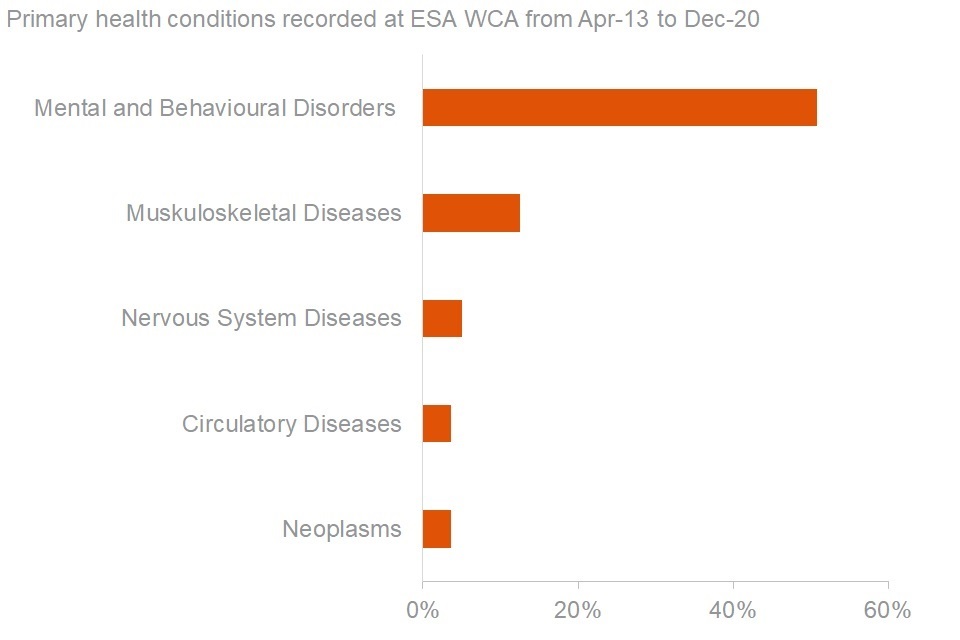
Source: ESA Work Capability Assessment tables
Mental and behavioural disorders were the most common primary health conditions at ESA WCAs between April 2013 and December 2020.
Mental and behavioural disorders were the most common primary health condition at ESA WCAs between April 2013 and December 2020. Mental and behavioural disorders accounted for 51% of primary health conditions. Musculoskeletal disorders accounted for 12, nervous system diseases for 5% and circulatory diseases and neoplasms for 4% each. Where someone has more than one diagnosis or disabling condition, only the primary one is reported on in these statistics. Data on health conditions for claimants on UC is recorded differently, and is not comparable to ESA WCA data.
Mental and behavioural disorders are made up of the following categories of conditions: organic, including symptomatic, mental disorders including Alzheimer’s disease, dementia and brain damage; mental and behavioural disorders due to psychoactive substance use; schizophrenia, schizotypal and delusional disorders; mood [affective] disorders including manic episodes, bipolar disorder, and depressive disorders; neurotic, stress-related and somatoform disorders including anxiety disorders, obsessive disorders, stress disorders and dissociative disorders; behavioural syndromes associated with physiological disturbances and physical factors; disorders of adult personality and behaviour; mental retardation; disorders of psychological development; behavioural and emotional disorders with onset usually occurring in childhood and adolescence; and unspecified mental disorder.
Neoplasms are an abnormal mass of tissue and may be benign (not cancer) or malignant (cancer).
Primary health conditions recorded for PIP clearances between April 2013 and January 2021
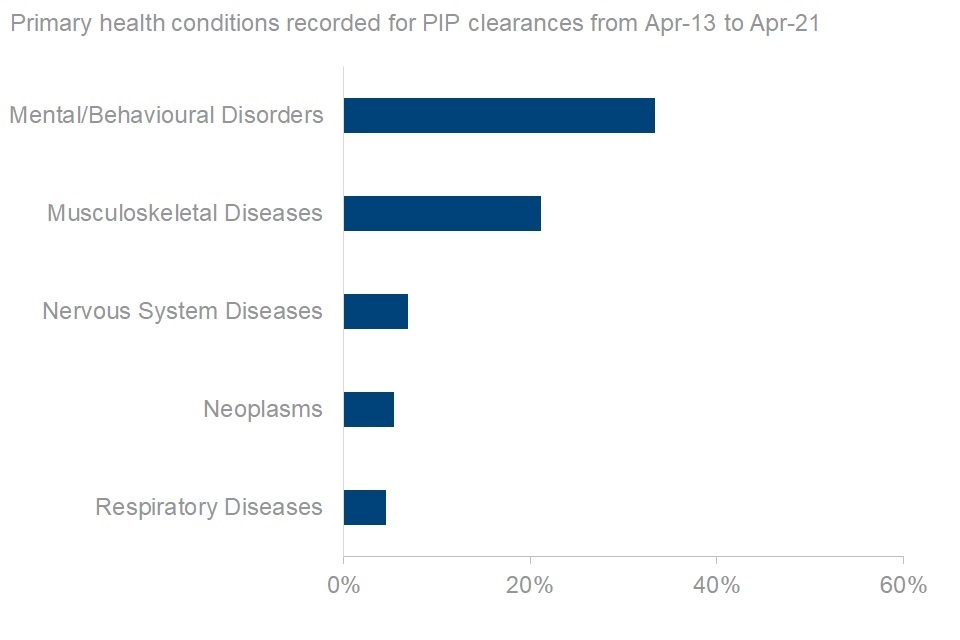
Source: PIP clearances tables
Mental and behavioural disorders were also the most common primary health conditions as PIP clearances between April 2013 and January 2021.
Mental and behavioural disorders were the most common primary health condition at PIP clearances between April 2013 and January 2021. These assessments include new claims and DLA reassessments. Where someone has more than one diagnosis or disabling condition, only the primary one is reported on in these statistics.
Of all PIP clearances, mental and behavioural disorders account for 29% of primary health conditions. Musculoskeletal diseases account for 21%, diseases of the nervous system 8%, neoplasms 5% and respiratory diseases 3%.
3. ESA initial WCAs awarding Support Group have increased over time but PIP new claim Enhanced awards have not
ESA initial WCA outcomes
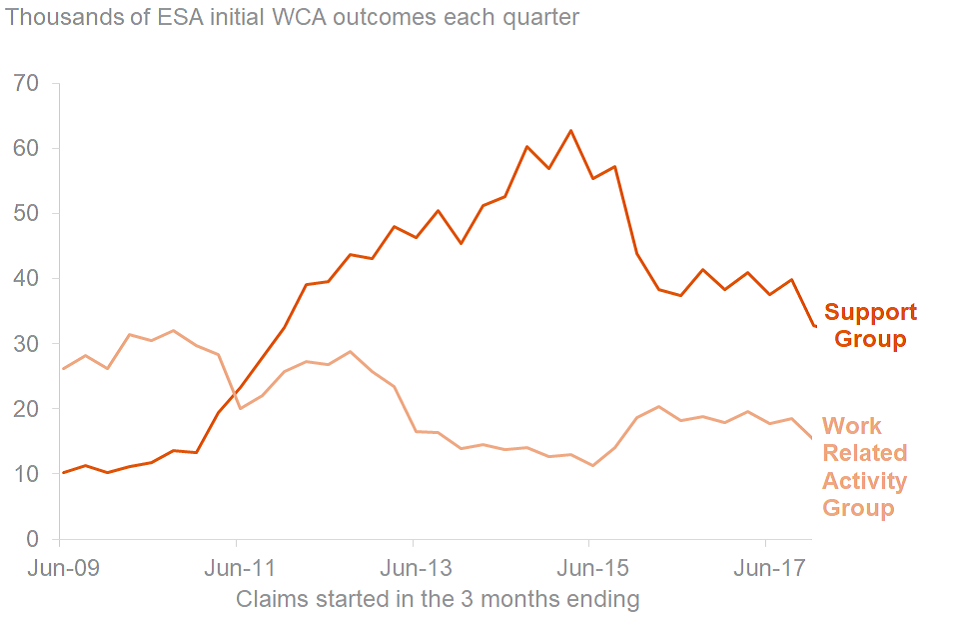
Source: ESA Work Capability Assessment tables
Between June 2009 and March 2018 the number of ESA initial WCAs awarded the Support Group each quarter increased from 10,000 to 32,000.
The number of ESA initial WCAs resulting in Support Group or WRAG decisions in each quarter has changed over time.
The number of ESA initial WCAs resulting in Support Group or WRAG decisions reduce from April 2018 due to the replacement of income-related ESA by Universal Credit. Data on UC WCA outcomes is not discussed here.
In the quarter ending June 2009 there were 10,000 ESA initial WCAs resulting in Support Group decisions and 26,000 that resulted in WRAG decisions.
In 2014 and 2015, Support Group decisions increased to 60,000 per quarter before reducing to 40,000 in September 2016.
In the quarter ending March 2018, the number of ESA initial WCAs resulting in Support Group decisions was 32,000. In this quarter, there were 14,000 ESA initial WCAs resulting in WRAG decisions.
This does not include reassessments of claimants who were previously in receipt of Incapacity Benefit (IB) or repeat WCAs for claimants receiving ESA.
PIP new claims
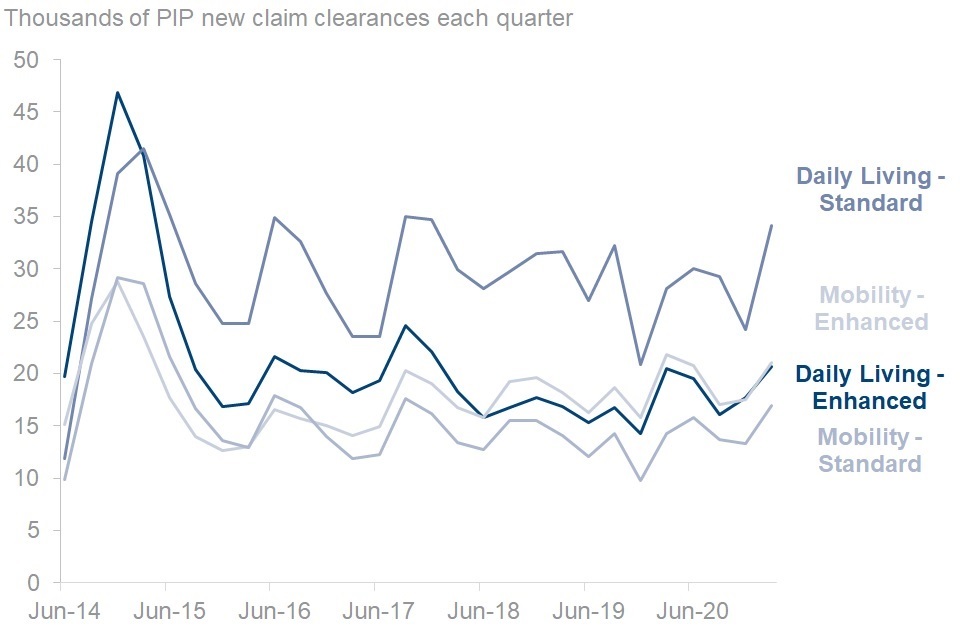
Source: Personal Independence Payments tables
By contrast, the number of PIP new claim assessments resulting in Enhanced award decisions have been volatile since 2017.
The number of PIP new claim assessments where people were awarded the Enhanced rate of the Daily Living component of PIP, the Standard rate of the Daily Living component, and Enhanced or Standard rate of the Mobility component, has varied over time between March 2017 and March 2021. Data on PIP assessments which were DLA reassessments is not discussed here.
Since June 2014 of PIP there have been between 20,000 and 47,000 PIP new claim assessments each quarter that have resulted in Enhanced Daily Living award decisions. In the same time there have been between 12,000 and 42,000 PIP new claim assessments each quarter that have resulted in Standard Daily Living award decisions.
Since April 2014 there have been 58,000 PIP new claim assessments each quarter have resulted in either an Enhanced or Standard mobility award decision.
4. The Support Group and LCWRA are making up an increasing share of the people on ESA and UC
ESA and UC* caseload that are in the Support Group/LCWRA
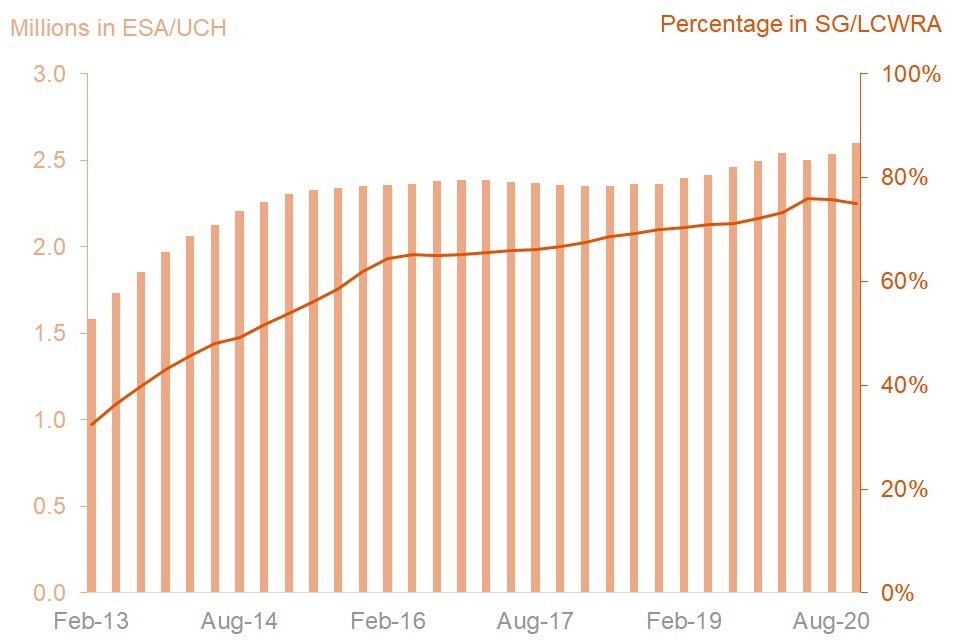
Source: Shaping Future Support Green Paper evidence pack
Between February 2013 and November 2020, the majority of those receiving ESA and UC* receive the highest rate, with no mandatory work related activity.
In 2013, 32% of the caseload were in the Support Group. The Support Group pays a higher financial award than other ESA payments, and people are not expected to do any work related activity.
As the number of people on ESA increased, including people being reassessed from Incapacity Benefit, the percentage of people in the Support Group increased. This increase has continued ever since. This increase has occurred while people with the most serious long term conditions have claimed and then remained on ESA or UC*.
Over the same time, people with less serious short term conditions have claimed ESA or UC* before leaving the benefit shortly after.
Over time, this leads to a larger proportion of people on ESA and UC* having serious long term health conditions, and being in receipt of the highest rate.
In November 2020, 2.6m people were receiving ESA or UC* (with some receiving both). 75% of these people were in the Support Group.
Since 2017 Universal Credit has gradually been replacing income-related ESA for people whose health condition or disability affects how much work they can do.
People receiving health-related income-replacement related benefits at each age
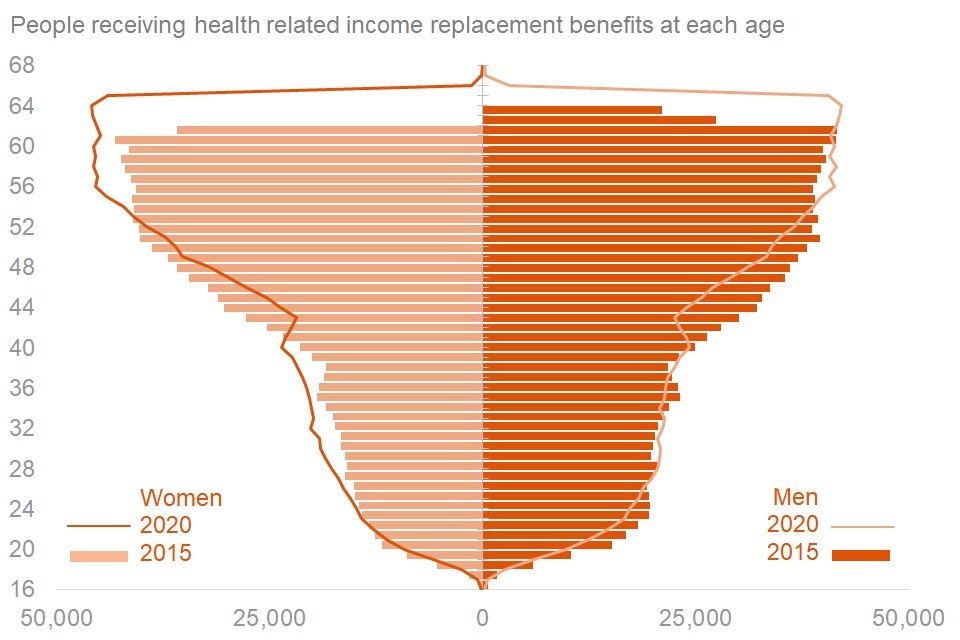
Source: Shaping Future Support Green Paper evidence pack
People receiving ESA and UC* are, on average, getting older.
In 2020, at most ages fewer people were receiving working age health related income replacement benefits such as ESA and UC* than in 2015. The ages which have increased the number of people receiving these benefits include ages 54 and above.
In 2015, only women aged under 62 would commonly receive working age benefits. This had increased to all women under the age of 65 in 2020.
The median average age of people receiving working age health-related income-replacement benefits increased from 47 in 2015 to 50 in 2020.
5. Fewer than 1% of people awarded the ESA Support Group leave the benefit each month
People on ESA Support Group, WRAG and assessment phase who exit each month
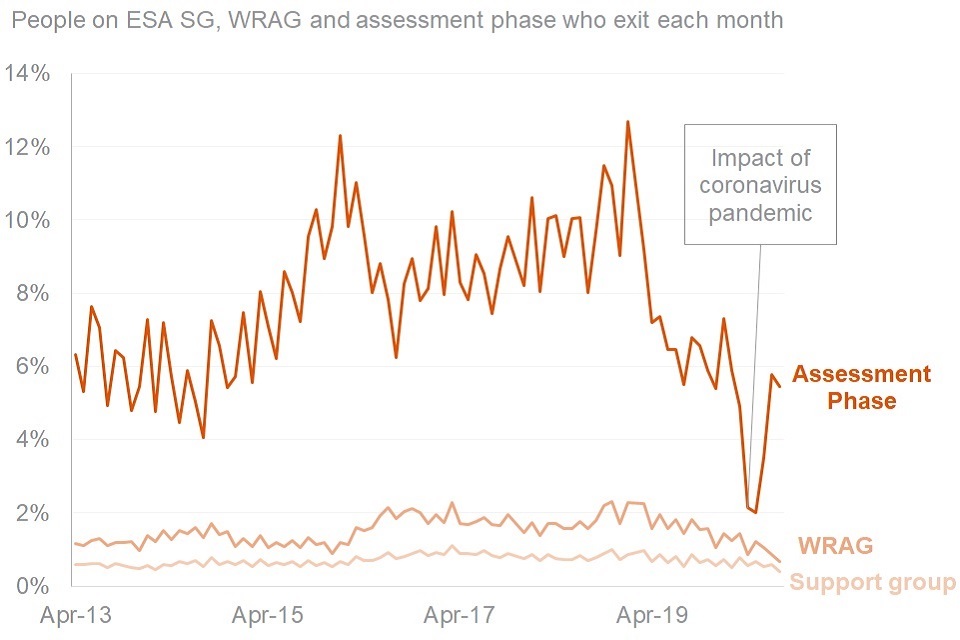
Source: Shaping Future Support Green Paper evidence pack
Between January 2011 and February 2021, less than 1% of people in the ESA Support Group exit each month.
For people in the Support Group, less than 1% of people in the group leave the benefit each month. For people in the WRAG group, since April 2013 the proportion of people leaving ESA has fluctuated between 1% and 3%. The assessment phase of ESA has the largest proportion of people who leave the benefit each month. People can be in the assessment phase for health conditions that limit their ability to work for both a long and short length of time. People with a short-term health condition that limits their ability to work can close their ESA claim before a Work Capability Assessment (WCA).
The proportion of people in Support Group and WRAG in 2016 to 2017 who left ESA each month
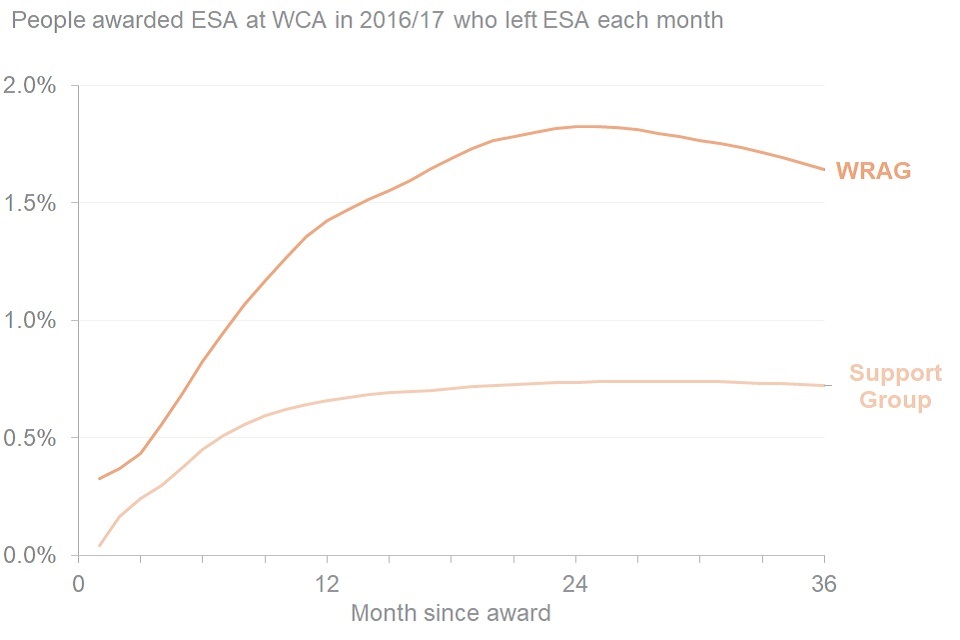
Source: Shaping Future Support Green Paper evidence pack
Out of people awarded Support Group on ESA following an initial WCA in 2016 to 2017, fewer than 1% per month subsequently left the benefit.
People in the Support Group and WRAG group on ESA include people who have made a claim to ESA over many different years.
Looking at the proportion of people who made a claim to ESA during 2016 to 2017, initially fewer than 0.5% of people who are awarded Support Group or WRAG at their initial WCA leave the benefit each month. After this, the proportion of people who leave the Support Group increases but remains lower than 1% per month. The proportion of people who leave WRAG peaks at 1.8%, 25 months after award, after which the proportion who leave ESA in subsequent months declines.
6. People who close an ESA claim usually do not go into employment
Outcomes for people who exited ESA in 2013 to 2014 in subsequent years
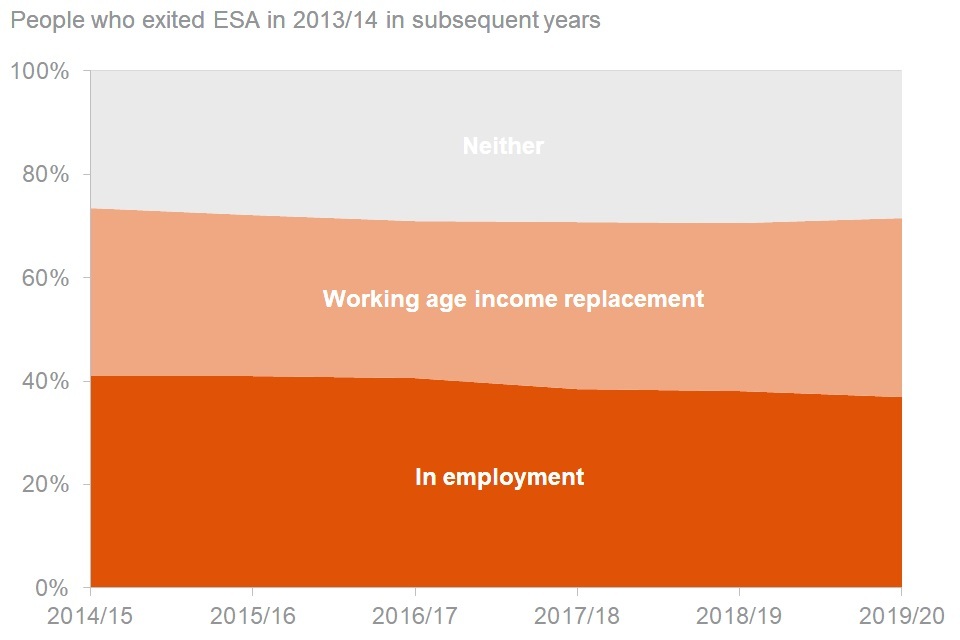
Source: Shaping Future Support Green Paper evidence pack
40% of people who left ESA in 2013/14 were in work the following year.
In 2013 to 2014, 40% of people who left ESA had a record of employment in the following year. The proportion of the people who left ESA in 2013 to 2014 and who are in employment in the years after this decreases slightly each year.
Outcomes for people who exited ESA in 2013 to 2014 in subsequent years
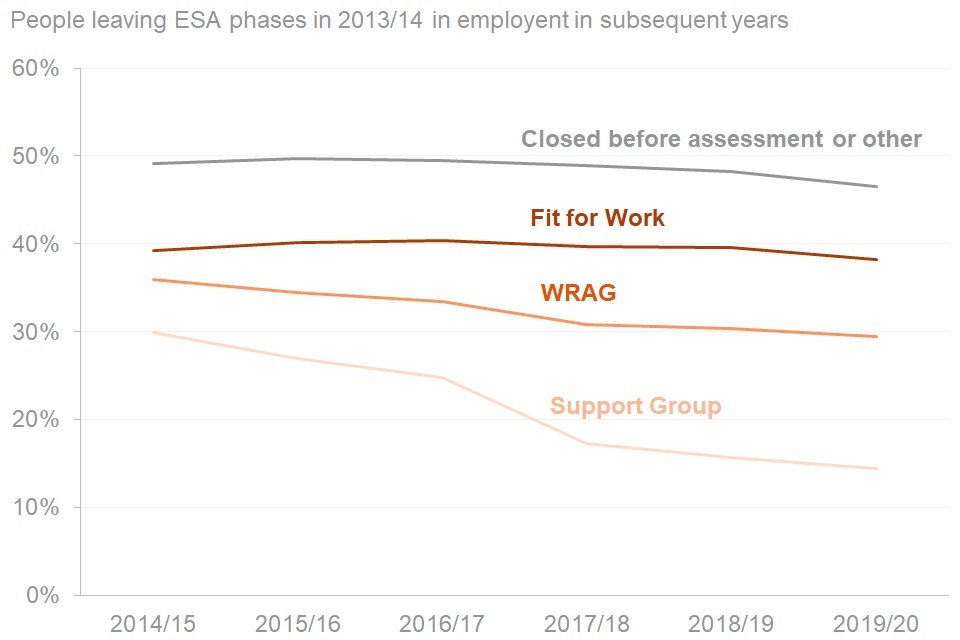
Source: Shaping Future Support Green Paper evidence pack
Less than 30% of people leaving ESA in 2013 to 2014 from the Support Group have a record of employment in subsequent years.
People leaving ESA in 2013 to 2014 whose claim was closed before assessment had the highest proportion of people in employment out of people leaving the different phases of ESA. Over 45% of this group of people had a record of employment in each of the subsequent 6 years.
People found Fit for Work (FFW) and leaving ESA in 2013 to 2014 had the second highest proportion of people in employment. Up to 40% of these people have a record of employment in subsequent years.
People leaving ESA in 2013 to 2014 who were in the Support Group had the lowest proportion of people in employment out of the different phases of ESA. Less than 30% of this group have a record of employment in subsequent years.
For people leaving all phases of ESA in 2013 to 2014 there was a decline over time in the proportion of people with an employment record. The Support Group cohort had the biggest decline, with 30% showing record of employment in 2014 to 2015 and only 14% in 2019 to 2020. For people found FFW and leaving ESA in 2013 to 2014, the proportion showing record of employment only dropped by 1pp from 2014 to 20120.
7. 14% of working age people on PIP are employed
PIP caseload by employment status in April 2019
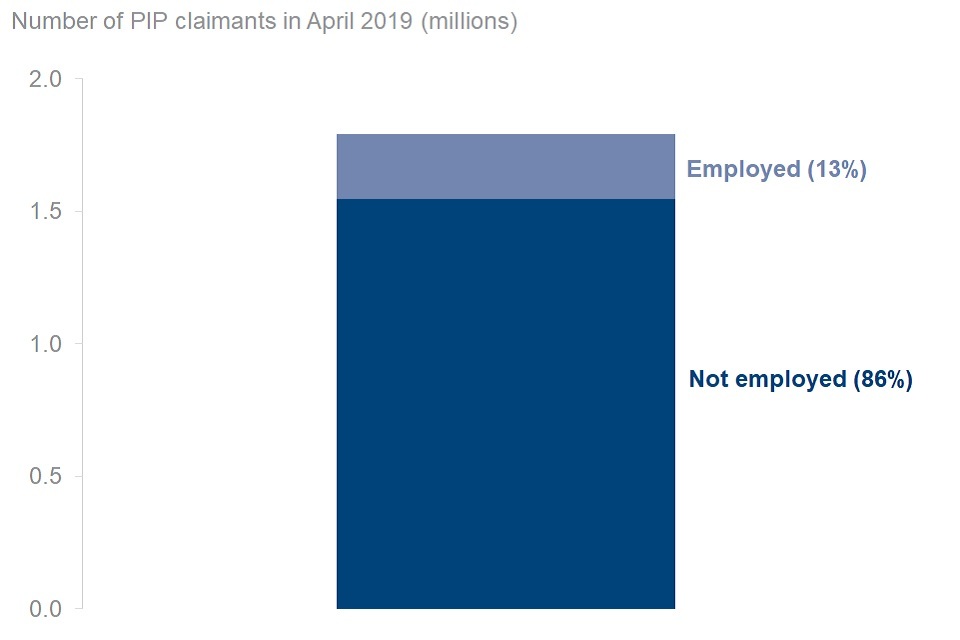
Source: Shaping Future Support Green Paper evidence pack
1 in 7 working age people receiving PIP in April 2019 were in employment.
Personal Independence Payment (PIP) can help you with some of the extra costs if you have a long-term physical or mental health condition or disability. You can get Personal Independence Payment (PIP) whether you’re working or not.
14% of working age PIP cases who were receiving PIP in April 2019 were also in employment during April 2019.
The employments status of new PIP cases in April 2019 and March 2020
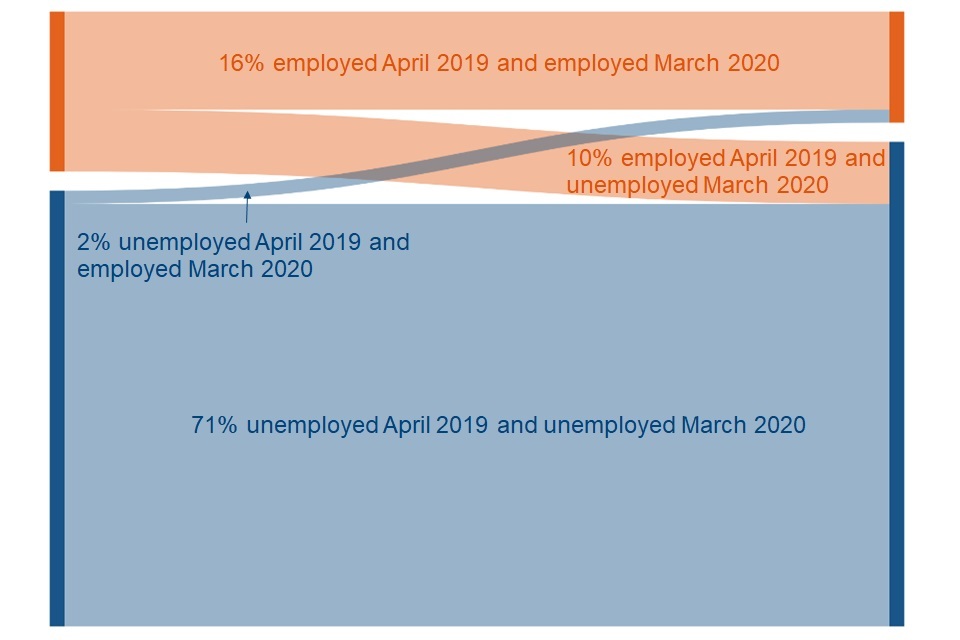
Source: Shaping Future Support Green Paper evidence pack
Most people on PIP are not in employment, and the proportion not in employment increases during the first year of their claim.
The employment status of 15,000 people who made a successful PIP claim in April 2019 has changed by March 2020, just under a year later.
8. Thousands of assessments are completed each month to determine awards for ESA/UC* and PIP
ESA WCAs conducted between April 2017 and March 2020
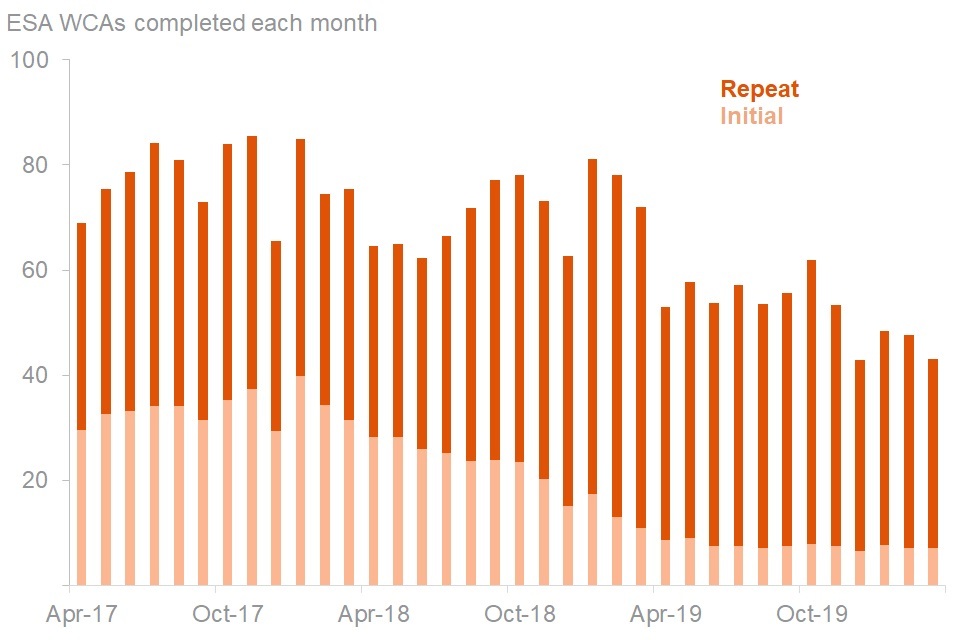
Source: ESA Work Capability Assessment tables
Between 43,000 and 85,000 WCAs were conducted every month to determine awards for ESA from April 2017 to March 2020.
The monthly total number of ESA WCAs, including initial assessments for new claims and repeat assessments, has varied between 39,000 and 93,000 each month between April 2013 and March 2020.
Initial assessment WCAs assess a claimant’s entitlement to ESA. Where someone is receiving ESA after an initial assessment WCA, their entitlement can be reviewed in a repeat assessment WCA.
Income-related ESA has now been replaced by UC for people making a new claim. People receiving UC who have a health condition that affects how much they can work are assessed with the same WCA as people receiving ESA. The volume of UC WCAs is not shown here.
PIP new claims and award reviews between June 2016 and January 2021
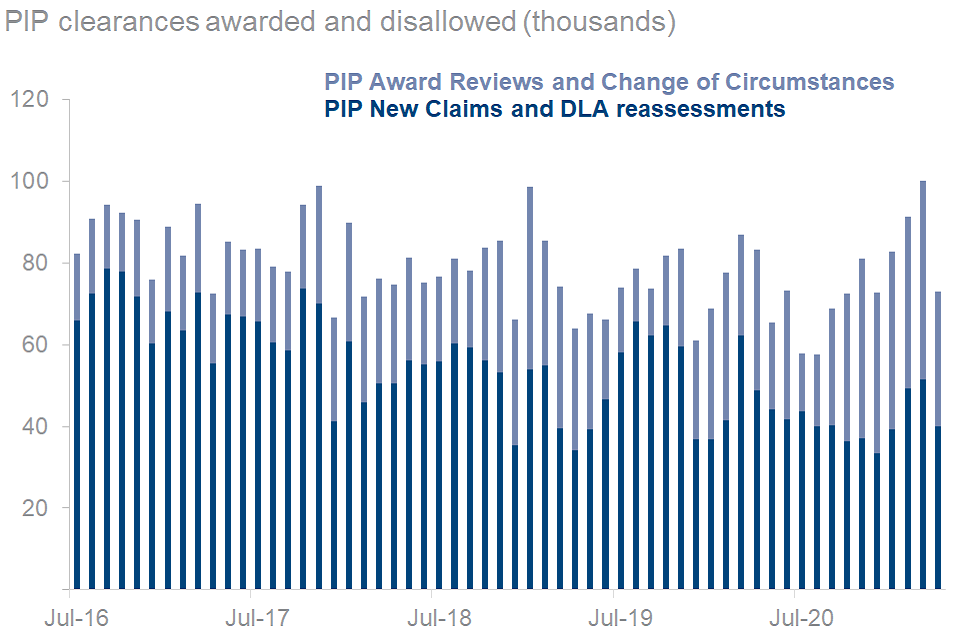
Source: Personal Independence Payment statistics
From July 2016 to April 2021 there were between 58,000 and 100,000 PIP clearances awarded or disallowed following assessment each month.
The monthly total number of PIP clearances awarded or disallowed following assessment has decreased between July 2016 and April 2021.
Information on PIP new claims and DLA reassessments include only clearances which award PIP or which disallow PIP following assessment.
PIP Award Reviews are conducted to review the entitlement of people receiving PIP, at the scheduled review date. A change of circumstances is when someone informs DWP of a change in their circumstances which may lead to a change in award. Since its introduction in 2013, the number of PIP Award Reviews has increased every year as more people reach their scheduled review date. The number of Changes of Circumstances has increased every year as more people receive PIP.
The number of PIP Award Reviews and Changes of Circumstances include only clearances which award PIP or disallow PIP following assessment.
9. ESA awards are reviewed less than once every 2 years, and PIP awards are getting longer
The median number of months since a previous WCA for ESA repeat WCAs

Source: Shaping Future Support Green Paper evidence pack
Repeat WCAs for claimants in the ESA Support Group, on average, take place more than 2 years after their previous assessment.
DWP can require people receiving ESA and UC* to be reassessed in a new WCA, known as a repeat WCA. This is to ensure that people receive the appropriate level of financial and employment support.
People continue to get their existing award until a new decision is made following a repeat WCA.
Since January 2016 the median length of time between assessments for people in the ESA Support Group has been between 21 and 37 months. The median time between assessments for people in the ESA Work Related Activity Group is shorter, as these people have been assessed as able to get back into work in the future.
PIP Award lengths at initial decision between 2014 and 2020

Source: Personal Independence Payments tables
Approximately a third of normal rules PIP initial decision awards were given ongoing awards or review periods of more than 5 years in 2019 to 2020.
When a PIP claim is awarded, there is an award type. This is the length of time until a PIP award review, or it can be an ongoing award, a terminal illness award or a short term award with no review date. A PIP award review is an opportunity to look at entitlement at set intervals to ensure that people continue to receive the correct award. The review point is selected based on the claimant’s individual circumstances
Since the introduction of PIP in 2013 the proportion of people awarded an ongoing award or a review period of more than 5 years has increased from 11% in 2014 to 31% in 2020.
10. Important terms and abbreviations
Terms and abbreviations used throughout this publication
Caseload
The number of people receiving a benefit.
Claim
A request for a benefit.
Disabled people
People with a disability or long-term health condition.
DLA
Disability Living Allowance, which is being replaced by PIP and helps with the extra costs associated with long-term ill-health or a disability.
ESA
Employment and Support Allowance, which people can apply for if they have long-term ill-health or disability that affects their ability to work.
IS
Income Support, which is extra money to help people on a low income or none. You can no longer make a new claim for Income Support. If you’re on a low income and need help to cover your living costs, you can apply for Universal Credit instead.
JCP
Jobcentre Plus, which provide services to some people who require financial assistance.
JSA
Jobseeker’s Allowance, which is an unemployment benefit people can claim while they look for work.
LCW
Limited Capability for Work, a group on UC where you are not expected to look for work right away.
LCWRA
Limited Capability for Work and Related Activity, a group on UC you are not expected to look for work or to prepare for work.
PIP
Personal Independence Payment, which can help people with some of the extra costs associated with long-term ill-health or a disability.
PSP
Personal Support Package, which offers tailored support for people in the ESA WRAG or Universal Credit LCW group.
SG
Support Group, a group on ESA for people who are assessed as not able to get back into work.
SRTI
Special Rules for Terminal Illness, if a person is living with a terminal illness and a doctor or a medical professional has said they might have less than 6 months to live, they may get benefits at a higher rate or get extra money and start getting payments quicker than usual.
TI
Terminal Illness, a health condition that a person will most likely die from.
UC
Universal Credit, which is a payment to help with living costs. It is replacing 6 other benefits. These are:
- Child Tax Credit
- Housing Benefit
- Income Support
- income-based Jobseeker’s Allowance (JSA)
- income-related Employment and Support Allowance (ESA)
- Working Tax Credit
UC*
People on Universal Credit (UC) who have had medical evidence checked as they have a restricted ability to work, or are assessed as LCW or LCWRA.
WCA
Work Capability Assessment, a functional assessment of a person’s fitness to work.
WHP
Work and Health Programme, personal support to help people find and keep a job if they are out of work.
WRAG
Work Related Activity Group, a group on ESA for people who are assessed as able to get back into work in the future.
Definition of medical conditions
ICD Group refers to the World Health Organisations’ International Classification of Diseases (2010) Condition Groups. These are sometimes referred to as medical conditions in DWP statistics. For reporting purposes, the conditions as recorded on DWP systems have been mapped to reflect as closely as possible the appropriate ICD10 code. Conditions are based on evidence provided and may not represent a person’s most recent medical condition. Where someone has more than one diagnosis or disabling condition, only the predominant one is reported on in these statistics.
The following abbreviations are used in these statistics.
| Abbreviation used in these statistics | ICD10 Description |
|---|---|
| Infectious Diseases | Certain Infectious and Parasitic Diseases (A00 - B99) |
| Neoplasms | Neoplasms (C00 - D48) |
| Blood/Immune System Diseases | Diseases of the Blood and Blood forming organs and certain diseases involving the immune mechanism (D50 - D89) |
| Metabolic Diseases | Endocrine, Nutritional and Metabolic Diseases (E00 - E90) |
| Mental/Behavioural Disorders | Mental and Behavioural Disorders (F00 - F99) |
| Nervous System Diseases | Diseases of the Nervous System (G00 - G99) |
| Visual Impairment | Diseases of the Eye and Adnexa (H00 - H59) |
| Hearing Impairment | Diseases of the Ear and Mastoid Process (H60 - H95) |
| Circulatory Diseases | Diseases of the Circulatory System (I00 - I99) |
| Respiratory Diseases | Diseases of the Respiratory System (J00 - J99) |
| Digestive Diseases | Diseases of the Digestive System (K00 - K93) |
| Skin Diseases | Diseases of the Skin and Subcutaneous System (L00 - L99) |
| Musculoskeletal Diseases | Diseases of the Musculoskeletal system and Connective Tissue (M00 - M99) |
| Genitourinary Diseases | Diseases of the Genitourinary System (N00 - N99) |
| Pregnancy | Pregnancy, Childbirth and the Puerperium (O00 - O99) |
| Perinatal conditions | Certain conditions originating in the perinatal period (P00-P96) |
| Congenital conditions | Congenital Malformations, Deformations and Chromosomal Abnormalities (Q00 - Q99) |
| Not classified elsewhere | Symptoms, Signs and Abnormal Clinical and Laboratory findings, not elsewhere classified (R00 - R99) |
| External causes | Injury, Poisoning and certain other consequences of external causes (S00 - T98) |
| External causes | External causes of morbidity and mortality (V01-Y98) |
| Health Services | Factors influencing health status and contact with health services (Z00 - Z99) |
| Unknown | Unknown or person without diagnosis on the system |
